
94% of researchers rate our articles as excellent or good
Learn more about the work of our research integrity team to safeguard the quality of each article we publish.
Find out more
ORIGINAL RESEARCH article
Front. Conserv. Sci., 13 October 2023
Sec. Conservation Social Sciences
Volume 4 - 2023 | https://doi.org/10.3389/fcosc.2023.1278699
This article is part of the Research TopicUnderstanding the Role of Local Knowledge and Human Emotions in Wildlife ConservationView all 8 articles
 Samuel Shephard1,2,3*
Samuel Shephard1,2,3* Jonas Muhindo1
Jonas Muhindo1 Jonas Nyumu1
Jonas Nyumu1 Emmanuela Mbangale1
Emmanuela Mbangale1 Sagesse Nziavake1
Sagesse Nziavake1 Paolo Cerutti1
Paolo Cerutti1 Nathalie van Vliet1*
Nathalie van Vliet1*Introduction: Indigenous communities typically hold diverse traditional ecological knowledge (TEK) of their social-ecological system. Much of this knowledge is embodied as skills related to subsistence practices within a specific landscape and is associated with community values and norms. Ways of knowing often reflect the different activities traditionally undertaken by men and women. The incursion of external forces, including urbanization, the cash economy and migration tends to diminish transmission of traditional embodied skills. Knowledge can be lost as culturally significant environments degrade or species become extirpated. Lack of opportunity to develop traditional knowledge and skills can diminish feelings of place and identity, and thus capacity for local environmental stewardship.
Methods: The Yangambi region, Democratic Republic of Congo is a hunting territory of the Turumbu ethnic group. We used questionnaires to explore how levels of wildmeat knowledge and skill may have changed over time among the Turumbu.
Results: The responses showed lower levels of self-reported skill among women who started to participate in the last 10-15 years. This pattern partly reflects the period of ‘apprenticeship’ but may also suggest diminished learning opportunity in recent years. Skills in cooking, smoking, and selling wildmeat persisted at a higher level than skills in curing disease and gathering wild produce. There was a much more marked pattern for men, with diminishing levels of wildmeat skill reported for around 35-40 years, and even earlier for knowledge of traditional medicine and wildmeat taboos. Questions about mentoring suggested that women have maintained knowledge pathways between mother and daughter, while men showed a shift toward increased learning from uncles.
Discussion: Gender differences in sharing and learning TEK may be linked to the type of skills that remain valuable in a changing social, ecological, and economic context. Men traditionally undertake the capture elements of hunting, while women deal with wildmeat processing, marketing, and cooking. The Yangambi wildmeat system has evolved from subsistence to a strongly market-driven economy during the lifetime of our study participants. This shift may partly explain why market-based kills such as food smoking and selling have endured longer than hunter’s nature-based knowledge.
Indigenous communities typically hold diverse traditional ecological knowledge (TEK) of their social-ecological system. Much of this knowledge is embodied as skills related to subsistence practices of hunting and gathering, and is associated with community values and norms and a broader cosmovision (Magni, 2017). Such embodied skills are strongly interwoven with sense of place, identity and cultural continuity in a relevant natural context, i.e., a 'taskscape' (Ingold, 2000); they connect body, mind, and environment (Raymond et al., 2018). Knowledge in this context is the link between feelings of care and responsibility for nature and practical agency relative to stewardship (embedded sustainable use) of local resources and ecosystems (Enqvist et al., 2018; Shephard et al., 2023).
Personal assimilation of TEK is a lifelong process, and older practitioners are expected to have deeper knowledge, e.g., of medicinal plants (Ayantunde et al., 2008), rare fishes (Braulik et al., 2022), forest succession (Schmidt et al., 2021) etc. Specific ways of knowing and relating to nature usually differ with gender in Indigenous communities, reflecting the activities traditionally undertaken by men and women (Souto and Ticktin, 2012; Gachuiri et al., 2022). Such differences seem to vary with scale, i.e., national, continental, or global (Torres-Avilez et al., 2016). Men can have more knowledge redundancy, e.g., of several plants that have the same medicinal function, but women may share information more widely and become more influential in knowledge transmission (Torres-Avilez et al., 2019). Skills and knowledge are passed on through everyday activities, local stories and songs (Reyes-García and Fernández-Llamazares, 2019). Children observe and imitate adults during the process of daily life (Lew-Levy et al., 2017; van Vliet et al., 2022b). Such cultural transmission of TEK is a dynamic process that reflects ambient conditions (Gómez-Baggethun and Reyes-García, 2013) and ongoing relations between mind, body and environment through time (Cooke et al., 2016). It allows for integration of new experiences and insights that could enhance food security and income generation, while enriching the cultural environment (Reyes-García et al., 2013).
Traditional skills and knowledge are acquired by humans through practice of significant and often cyclical activities within their taskscape. This process requires multi-generational participation and mentoring that helps build relational values linked to sense of place, identity and care (West et al., 2018). Incursion of outside forces, including urbanization, the cash economy and significant in- and out-migration tends to diminish development and transmission of traditional embodied skills (Kik et al., 2021). Skills no longer necessary for survival may be lost or retained at a lower level of mastery as traditional lifestyles, links to place and modes of education change (Ohmagari and Berkes, 1997). Important knowledge can also be lost as culturally significant environments degrade or species become extirpated (Turvey et al., 2018). Loss of LEK and reduced opportunity to acquire skills may diminish capacity for good environmental stewardship, by reducing feelings of personal and communal responsibility for nature (Reid et al., 2021). Losing this emotional connection to a social-ecological system may occur in tandem with erosion of resource boundaries and sanctioning mechanisms that are key to self-governance (Ostrom, 1994), cumulatively impairing efforts in community-based wildlife management (Benyei et al., 2022). This unravelling can have serious implications for the resilience of Indigenous communities, reducing capacity to endure environmental shocks such as pest infestation (Bentley and Rodriguez, 2001), extreme weather events (Kuhnlein and Turner, 2020) or climate change (Gómez-Baggethun and Reyes-García, 2013).
Indigenous knowledge, livelihoods and culture are currently the focus of a renewed effort by many communities seeking to re-establish their identity and attain legal recognition of territorial rights and responsibilities (Macfarlane and Olive, 2021; Lindstrom, 2022). This renaissance, and its associated benefits for biodiversity conservation, may be compromised by loss of embodied Indigenous knowledge (Fernández-Llamazares et al., 2021; Kik et al., 2021). It is important to understand how and when development of traditional knowledge and skills proceeds over time, and whether this process is uneven within a community, e.g., between genders.
The Yangambi region, Democratic Republic of Congo (DRC) is an extensive hunting territory of the Turumbu ethnic group. The Turumbu are a riparian people thought to be part of the larger Bantou group of Topoke-Lokele-Turumbu-Basoko; they speak several languages including Lombo and Lingala. The Turumbu are known for their traditional hunting skills, and the wildmeat system around Yangambi is extremely important to local food security (van Vliet et al., 2022a). The forest in this region remains relatively healthy, but there has been significant decline among important target species (van Vliet et al., 2018) and strong shifts in the hunting social-ecological system (Shephard et al., in review). Various aspects of Turumbu traditional knowledge and culture may have been lost to colonization and modernity (Koy and Ngonga, 2017). We used questionnaires to explore how individual levels of embodied wildmeat knowledge and skills may have changed over time, and how this knowing is shared across living generations of Turumbu men and women in the Yangambi region.
Yangambi town is in the North-East of the DRC, about 100 km West of Kisangani City in the Tshopo Province (Figure 1). As is typically observed in Congo Basin forests, the landscape around Yangambi is characterized by a superposition of land tenures combining the existence of the Yangambi Man and Biosphere Reserve (YBR) created in 1979, the legally contested Ngazi Forest Reserve, a logging concession to the north-West of the YBR and Turumbu customary land. In practice, due to the lack of human and financial resources, the YBR has no official management plan, its limits are contested, and it is not under any specific form of management. Deforestation in the YBR may not differ from bordering areas (Kipute et al., 2023).
Our focus within this landscape was the hunting territory of Weko, a Turumbu village located 30 km to the north of Yangambi town. The territory of Weko covers an area of about 30 000 ha. In Weko, the main livelihoods are shifting cultivation, hunting, fishing, canoe construction and gold mining. The village of Weko provides around 66% of the wildmeat biomass sold in the town of Yangambi - an equivalent of about 97.6 tons of smoked meat per year. Despite this large catch, food security is poor because most of the hunting occurs for commercial purposes, with more than 80% of the biomass being sold to the Yangambi market. The main species sold are small monkeys and red duikers, followed by blue duikers, bush pigs and brush tailed porcupines (van Vliet et al., 2018).
A set of standardized questions was used to elicit perceptions of local knowledge and skills related to various aspects of the wildmeat hunting system, and to explore how these dimensions might differ among practitioners across the observed gradient of age and experience. The questionnaire was first developed in French, and conversations predominately in Lingala and Turumbu. Each respondent was first asked to record how old they were when they started to learn specific wildmeat skills, and how old they are now. Time in the system (age now minus age at start) was then calculated as a period of ‘participation’ in years (Shephard et al., 2021). This variable provided the basis for plotting time series of perceived wildmeat knowledge and skills in the community. The sets of questions were developed through a series of preliminary discussions with separate groups of young and old men and women. Each group was asked to describe what they perceived as the most important skills and knowledge (related to wildlife) that characterize a Turumbu woman or man. The groups then ranked these criteria for man- or womanhood. We selected all the consistently reported characteristics and used these to formulate relevant questions.
Following this approach, the number and type of skills, and the resulting sets of questions differed for men and women based on key traditional tasks identified for each group (Table 1). Questions were phrased as “what is your level of knowledge and skill…?” For example, the women’s groups indicated that a Turumbu woman should be able to butcher game skillfully, and so the first question to women was ‘What is your level of knowledge and skill in butchering game?’ (Table 1). Respondents were asked to select their perceived level according to a 6-point Likert scale extending from “no idea” to “I can do it myself and train others.” Each respondent was also asked who taught them the skill referred to in each question. They could select from “Mother”, “Father”, “Aunt”, “Uncle”, “Friends” and several other close relations. The reported level of skill and the identified primary mentor for each skill were the main information used in the subsequent analysis.
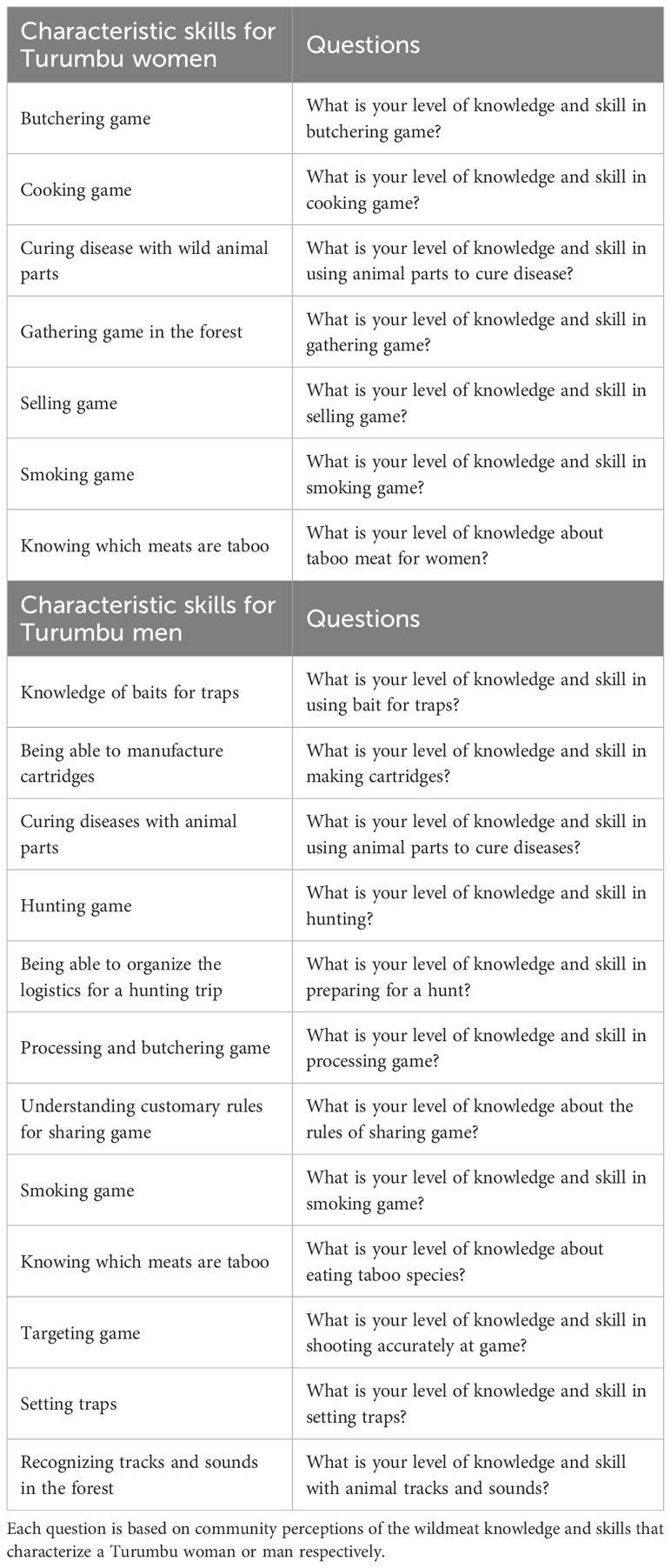
Table 1 Questions about wildmeat knowledge and skills presented to each of women and men in the study community.
The first objective was to explore whether the level of self-reported wildmeat expertise changed over the observed range of experience (‘participation’, years to present) for respondents. Each of the set of possible responses to the questions (Table 1) was coded numerically as follows: “I can do it myself and train others” (score 4), “I can do it by myself” (score 3), “I can do it if someone helps” or “I have seen it done” (score 2), and “I have heard about it” or “I have no idea” (score 1). The responses referring to lower levels of skill (scores 1 and 2) were paired because they were each relatively uncommon. An important aspect of this analysis was to identify the typical age at which men and women each started to learn and participate in their characteristic skills, and how quickly they attained a self-reported higher skill level (at least score 3 or 4). This information was presented in plots that show starting age, current age and perceived current skill level (Figures 2, 3).
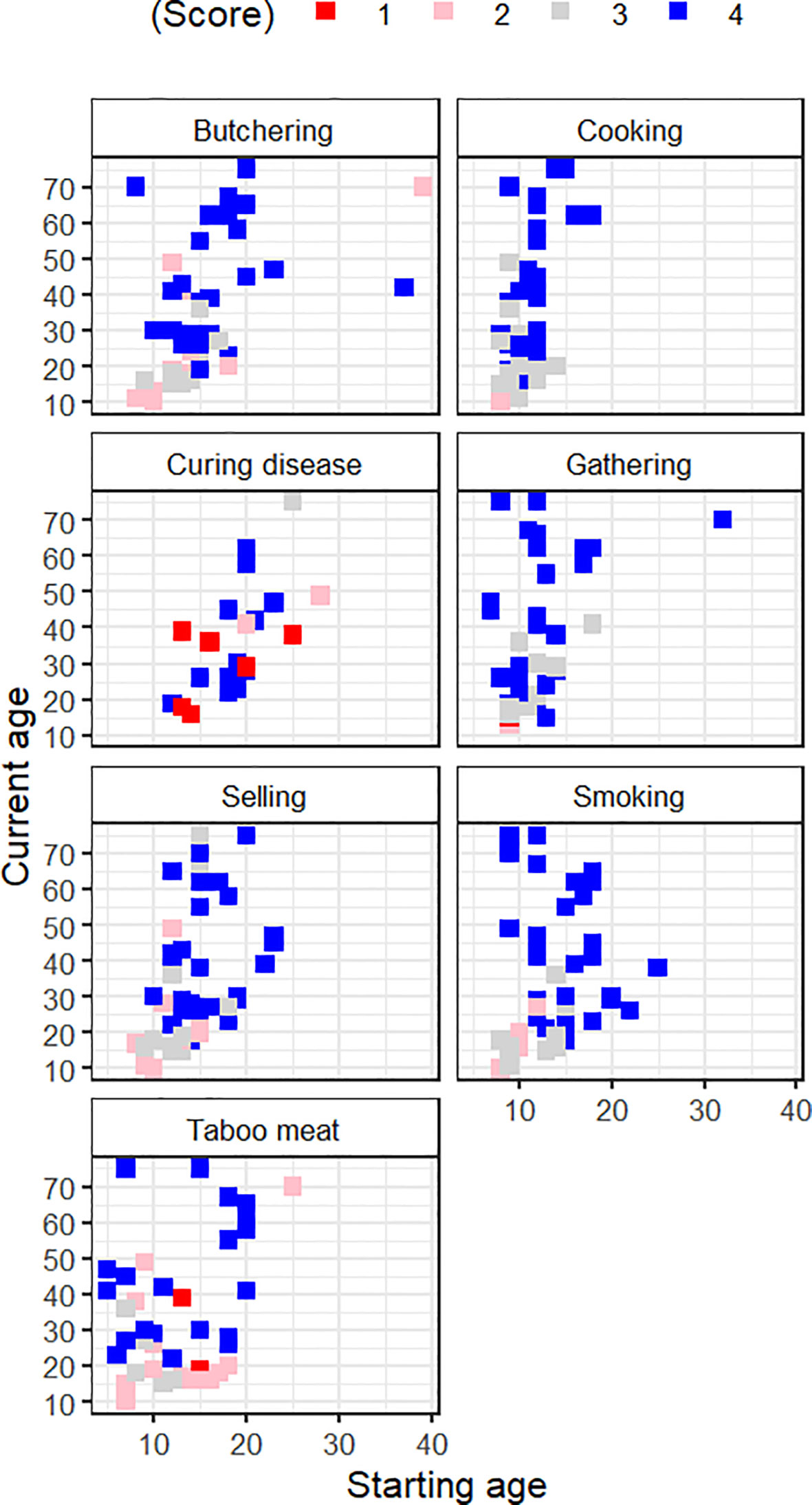
Figure 2 Current age (years) of female Turumbu respondents and the age at which they started to learn and participate in each skill. The color of the points indicates their reported level of skill, scored as “I can do it myself and train others” (score 4), “I can do it by myself” (score 3), “I can do it if someone helps” or “I have seen it done” (score 2), and “I have heard about it” or “I have no idea” (score 1).

Figure 3 Current age (years) of male Turumbu respondents and the age at which they started to learn and participate in each skill. The color of the points indicates their reported level of skill, scored as “I can do it myself and train others” (score 4), “I can do it by myself” (score 3), “I can do it if someone helps” or “I have seen it done” (score 2), and “I have heard about it” or “I have no idea” (score 1).
Reported skill levels then needed to be evaluated in relation to the length of participation (years up to the present) for each respondent and skill. Responses were collated into nine participation increments (bins), representing from 5 up to 50 years’ experience, with 3-6 (usually 4-5) respondents per increment. The proportion of respondents reporting each skill level (score 1-4) at each participation increment was then expressed using a Likert plot (diverging stacked bar charts, Figures 4, 5) for each skill question (Table 1). The plots therefore provide time series of perceived wildmeat knowledge and skill across the observed participation gradient (Shephard et al., 2021), revealing if and when the proportion of people reporting higher skill levels may have diminished. The question of changing skill levels over time was also tested statistically by fitting linear regression models to the proportion of respondents in each career increment that reported a high level of skill (score 4). Two models were fit for each male and female skill, allowing either a straight line or a quadratic curve. The two models were compared using AIC to identify best fit for each skill, but a p-value for the effect of participation length was reported for each model.
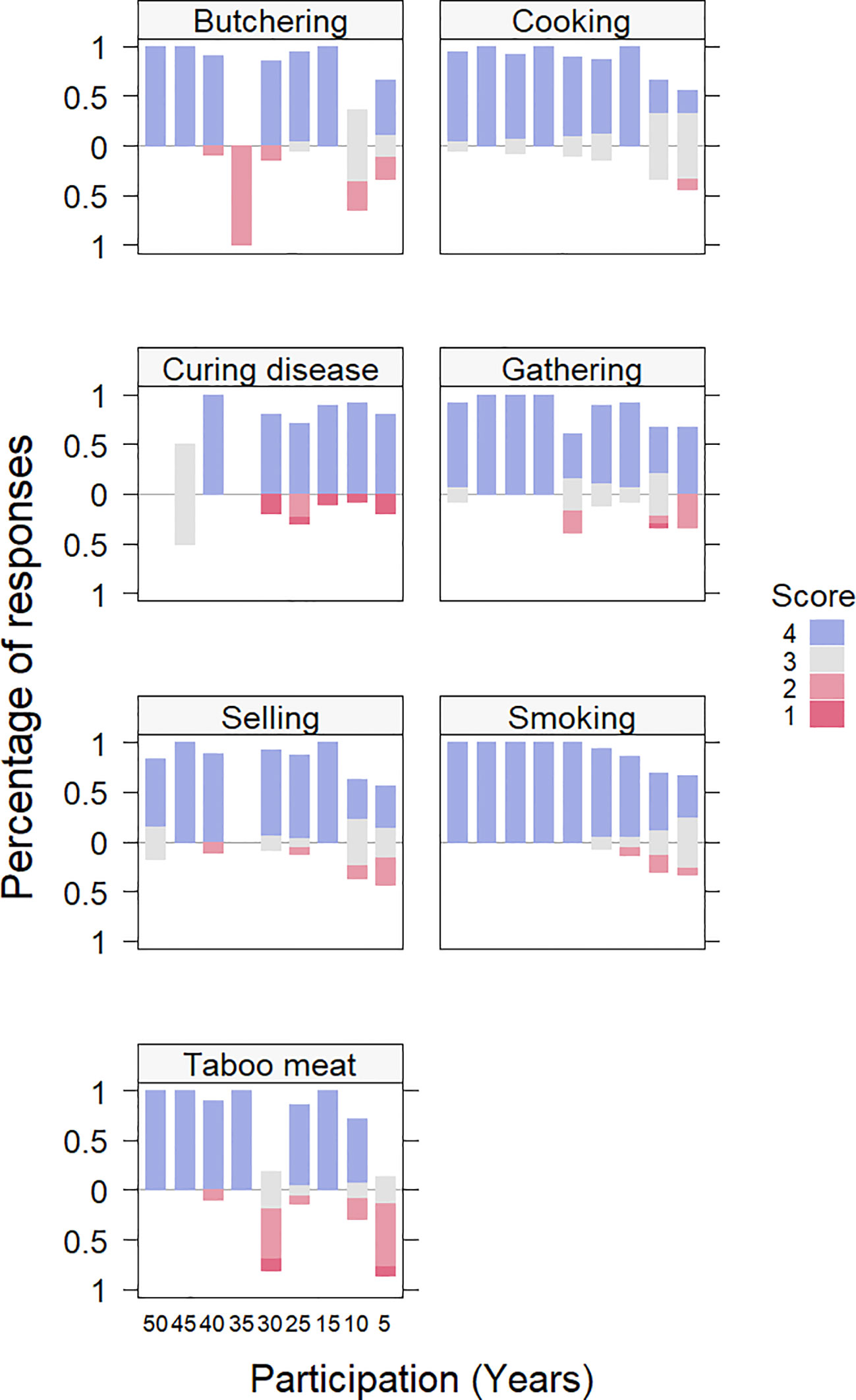
Figure 4 The proportion of women at each participation increment giving each of four possible classes of response to seven different questions (Table 1) about their wildmeat knowledge and skills. The four responses are “I can do it myself and train others” (score 4), “I can do it by myself” (score 3), “I can do it if someone helps” or “I have seen it done” (score 2), and “I have heard about it” or “I have no idea” (score 1).
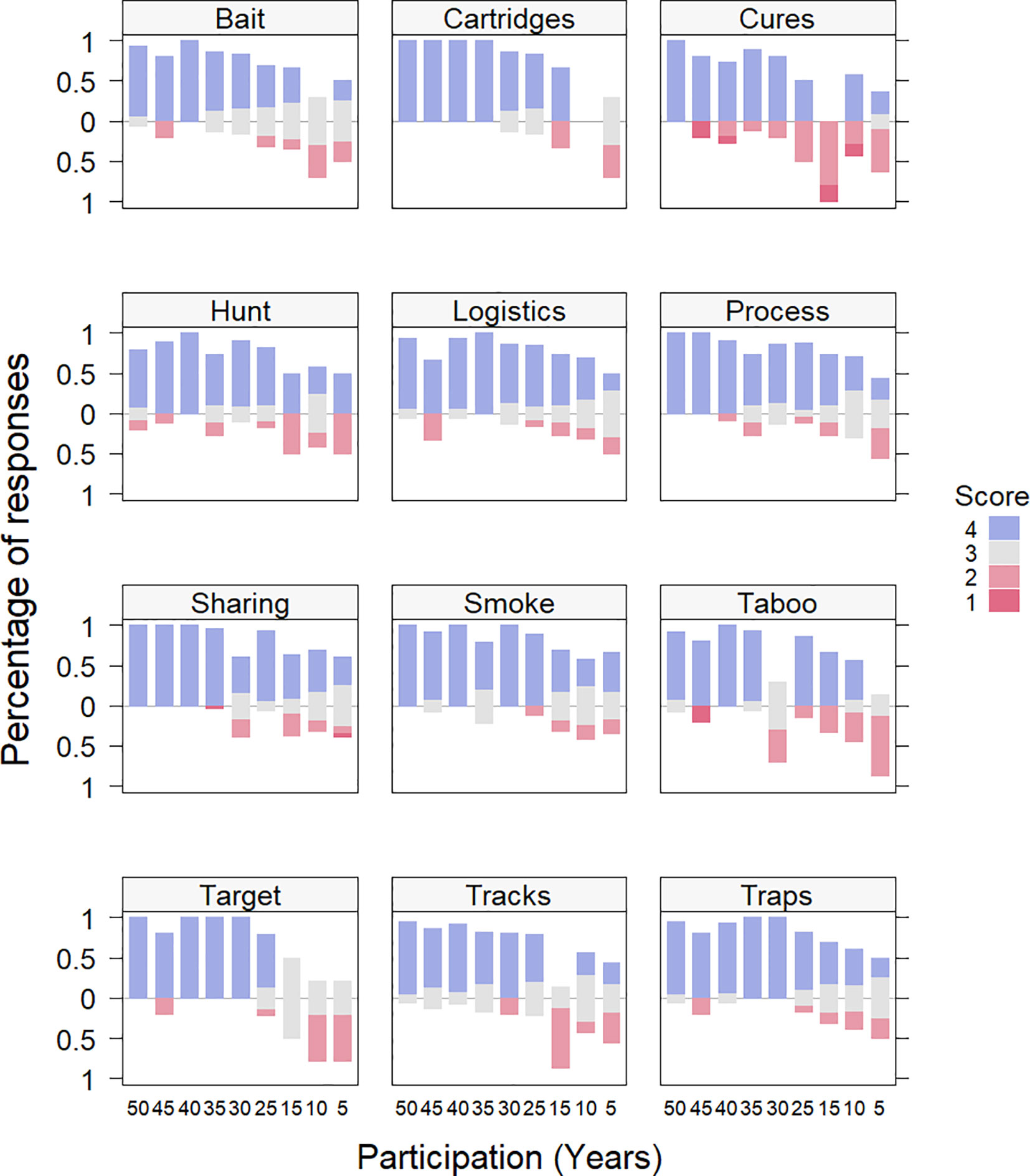
Figure 5 The proportion of men at each participation increment giving each of four possible classes of response to 12 different questions (Table 1) about their wildmeat knowledge and skills. The four responses are “I can do it myself and train others” (score 4), “I can do it by myself” (score 3), “I can do it if someone helps” or “I have seen it done” (score 2), and “I have heard about it” or “I have no idea” (score 1).
The second objective was to consider whether the most frequently reported wildmeat mentor tended to differ between people with longer and shorter periods of participation in Turumbu skills. Reported mentor was aggregated across all skills questions and then plotted for men and women across three participation bins (0-15, 15-35 and >35 years up to the present). This plot provided a simple summary of the primary transmitters of knowledge reported across three consecutive time periods. Because the primary mentor seemed to change for men (not women), a table of observed values for men was then provided for additional insight.
The original questions and discussions suggested ongoing changes in the level of embodied skills and knowledge among Turumbu men and women. In order to reflect on these results with local people, four separate focus groups were subsequently conducted in Weko and Ngazi villages. There was a group of three old people (men and women) and another of four old people (men and women). There was also a group of 11 young women and finally a mixed group of men from 25-75 years of age. These groups considered outcomes from the primary questionnaire, and a supplementary set of questions was used to further explore perceptions of how young people are now connected to Turumbu traditional knowledge and skills, especially related to hunting and wildlife (Table 2).
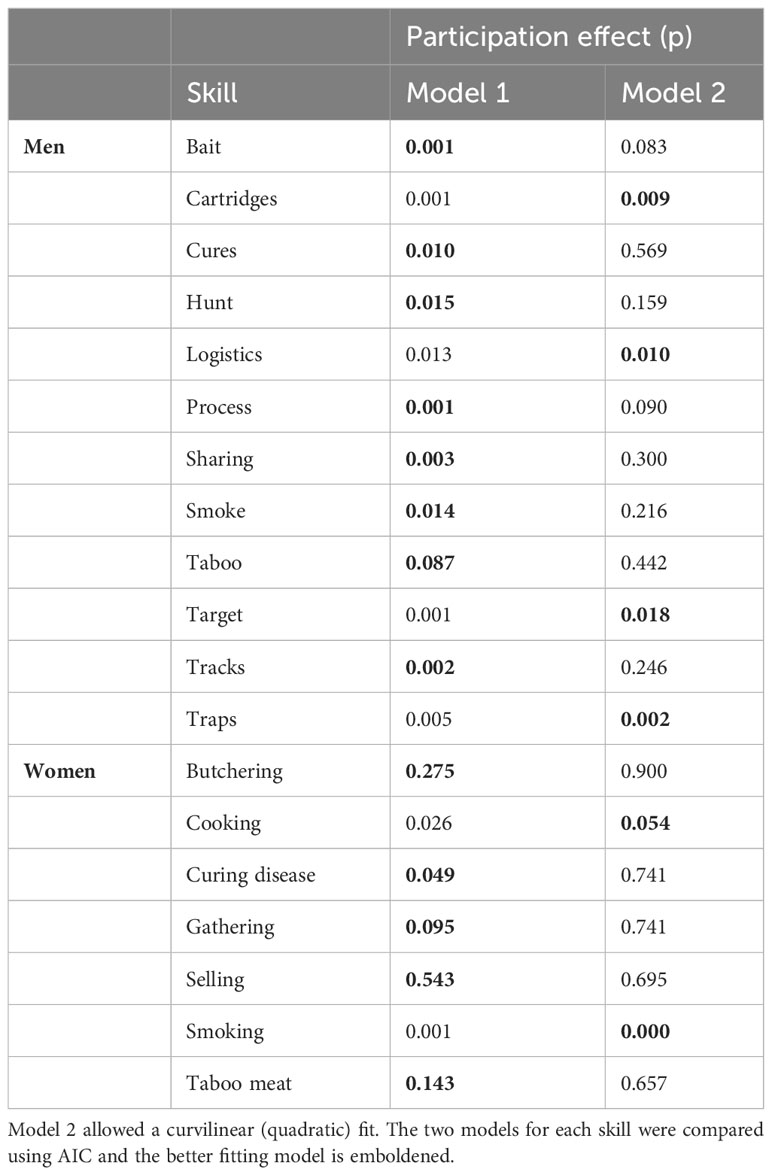
Table 2 Outcomes (p-values) from two linear regression models testing the effect of participation (nine increments from 5 to 50 years) on proportion of respondents reporting a high skill level (score 4).
There were a total 47 male and 53 female respondents for the questionnaires. The plots of starting and current age and the level of reported skill showed some visual contrasts among the characteristic tasks of Turumbu. Learning of some skills commenced at a younger age (<10 years), especially cooking, gathering and taboo meat for women (Figure 2), and tracking and trapping for men (Figure 3). Other tasks such as curing disease (women) and making cartridges or aiming a gun (men) started at a later age.
Self-reported expertise in most wildmeat skills appeared lesser among women who entered the wildmeat system in the last 10-15 years. The timing and degree of change differed across questions, with skills in curing disease and gathering wild produce possibly diminishing earlier (i.e., more Likert scores of 1 or 2) than skills in cooking, smoking and selling wildmeat (Figure 4). The recent lower level of knowledge and skills was much more marked for men, with a diminished level of expertise evident among those with participation shorter than 30-35 years. Diminished sharing and learning of knowledge related to curing disease and wildmeat taboos may have started even earlier and subsequently become more severe (Figure 5).
The fitted regression models showed that the proportion of men reporting a high skill level (score 4) decreased approximately as a straight line with shorter participation, i.e., more recent entrance to the system (Model 1), and this negative effect was strongly significant (Table 2). For women, the participation effect on proportion of high skill level was only important for cooking and smoking, which showed patterns resembling the data for men.
The contrast between men and women in time series of wildmeat skills may be linked to the key mentors that each group reported. Most women indicated that they learnt wildmeat skills mainly from their mother, and to a lesser extent from their father. This pattern did not appear to change much over the observed range of experience in the system (Figure 6). In contrast, men historically tended to be mentored primarily by their father, but there was a strong shift over time toward an important training role for uncles (Table 3, Figure 7). Fathers were important mentors to women, but relatively few men reported being mentored by their mother.
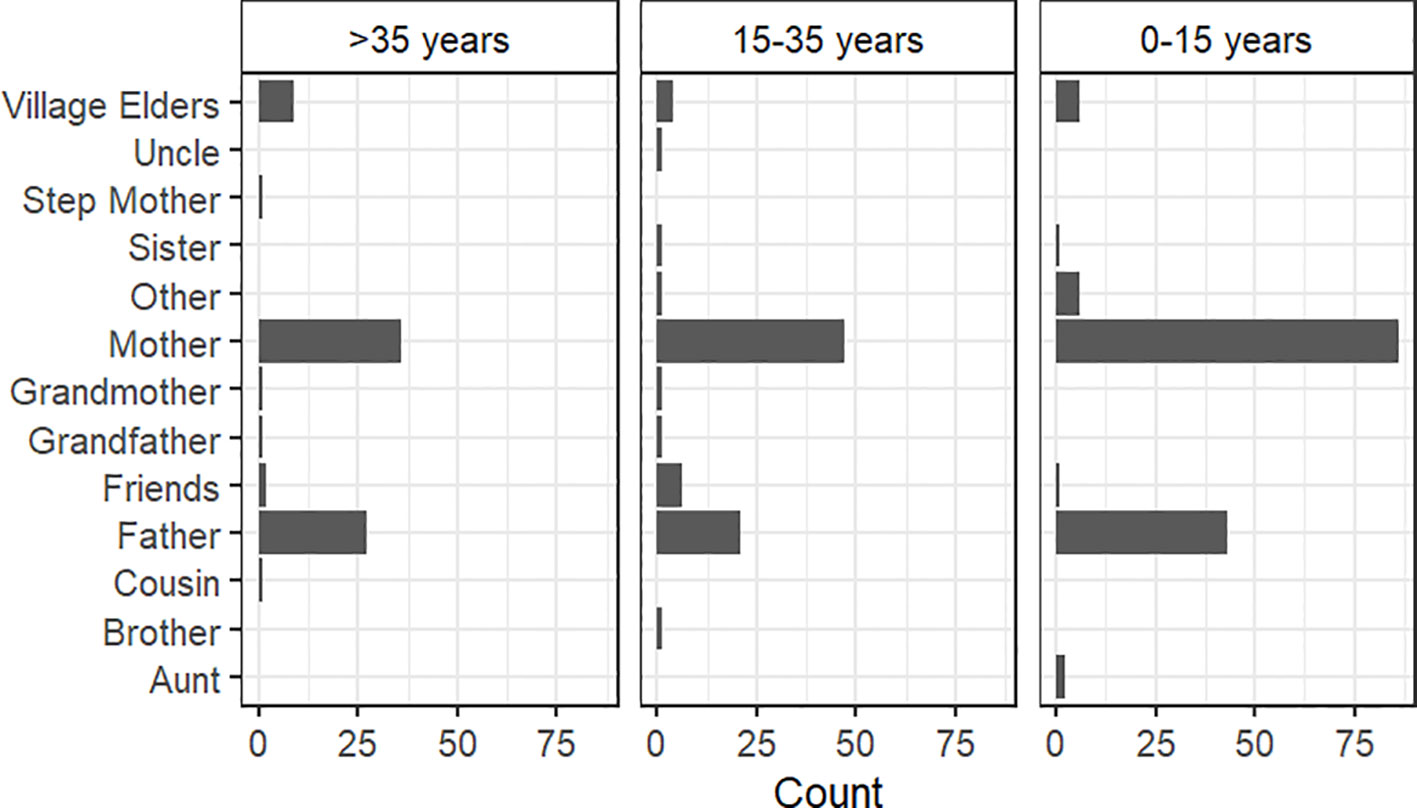
Figure 6 Summary of primary mentors for women in three classes of career length. Bars show the number of responses for each mentor class summed over the seven wildmeat questions (Table 1).
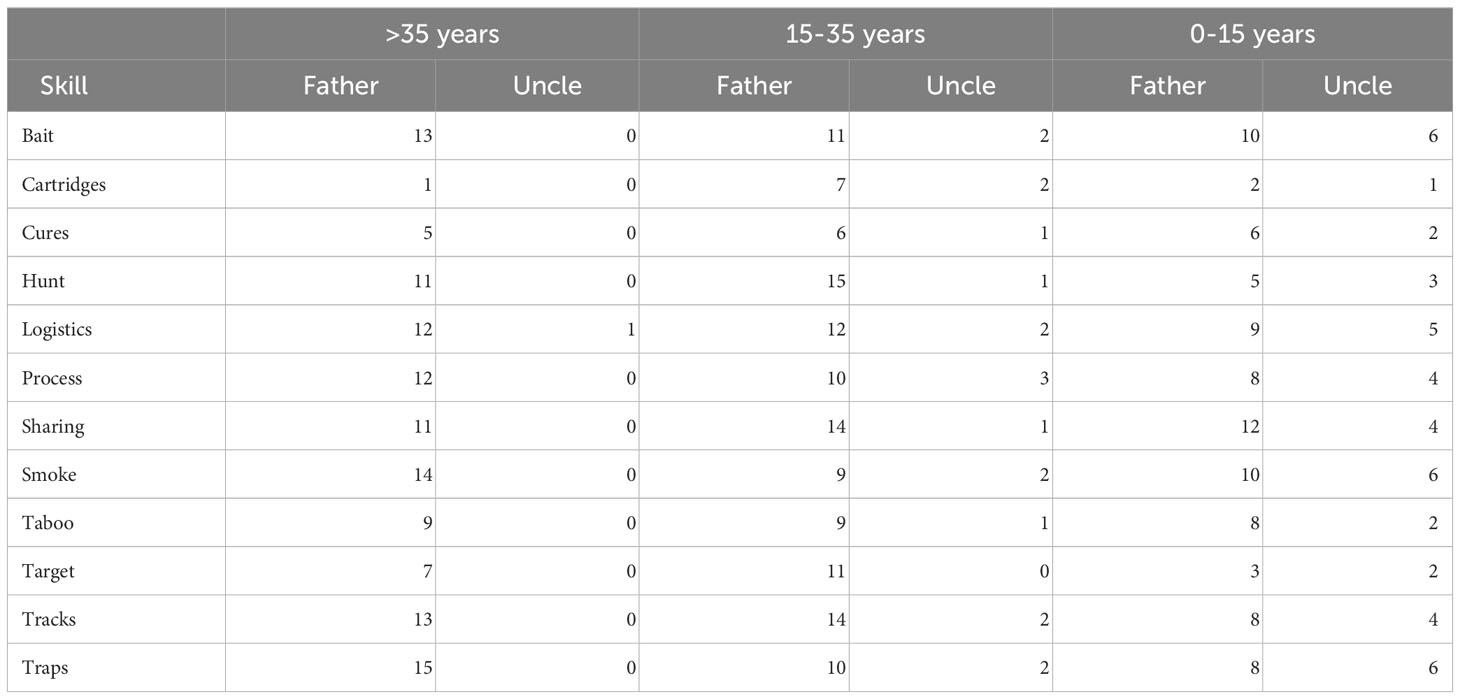
Table 3 Number of men in each of three participation increments for each skill who reported being mentored primarily by either their father or uncle.
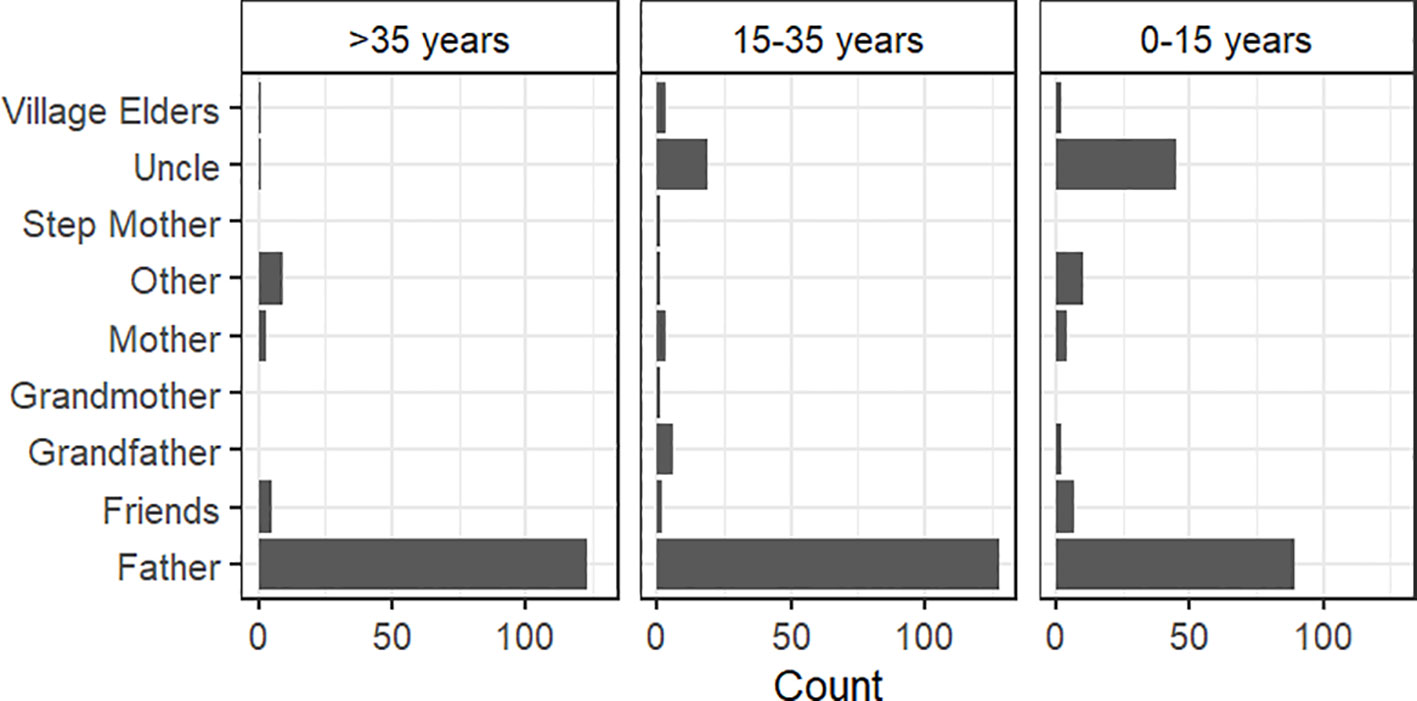
Figure 7 Summary of primary mentors for male hunters in three classes of career length. Bars show the number of responses for each mentor class summed over the 12 hunting questions (Table 1).
The secondary focus groups helped to clarify local perceptions of current Turumbu identity and maintenance of traditions by young people. Four separate focus groups, each involving 3 to 11 Turumbu men and women provided a consistent picture. The general feeling was that young people are still broadly connected to the tradition but are losing interest in the details and are subject to outside influences. The important role of parents in maintaining transmission of wildmeat knowledge and skills was highlighted (Table 4).
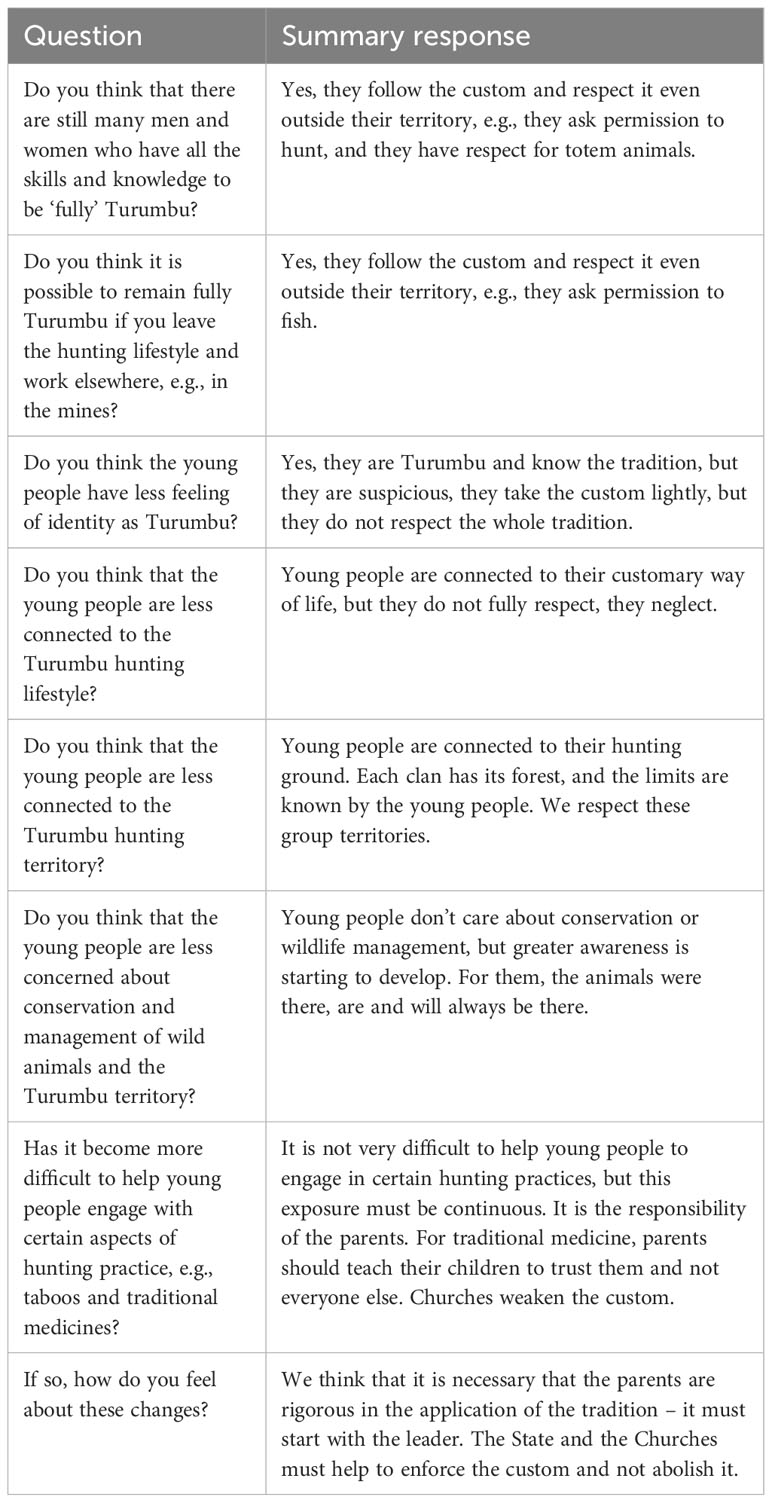
Table 4 Supplementary questions and answers discussed in four small focus groups to help interpret results from the main study.
Traditional ecological knowledge is not just abstract information. It comprises the accumulated environmental knowing and awareness of an Indigenous community. This insight is typically embodied in practical skills that are critical for survival and sustainable use in a specific social-ecological system and woven into relationships within a broader landscape and cosmovision. Loss of TEK thus diminishes not just practical capacities, but also local environmental stewardship capacity and cultural integrity. We used closed-answer questionnaires to evaluate the level of TEK held by successive living generations of Turumbu people in the Yangambi region, DRC. The focus was on skills and knowledge that were perceived locally as important criteria for being a Turumbu man or woman.
There was strong evidence for a lower level of skills among people starting to learn and participate in more recent years. The most marked effect was for knowledge and skills related to ethnic medicines and wildlife taboos, which might be associated with a more intact traditional lifestyle. However, women seemed to have retained a higher level of learning and skills for longer than men (Figures 4, 5). Women also better maintained pathways of knowledge transmission from mother to daughter, while men showed a shift from father to son transmission toward increased learning from uncles (Figures 6, 7). Learning from uncles may have increased, but it is perceived locally to be grounded in tradition. One of the field team concluded from the focus group discussions that “Many Turumbu children are raised in their mothers’ families, where newborns are given more consideration by their uncles who have a bond of affection without taboo. Young people can sometimes confide more easily in uncles than in their fathers and will learn a lot”. There may also be an effect of fathers living and working elsewhere, e.g., in the mines.
It is very important to recognize that the current results probably reflect two different mechanisms: (1) the likelihood that knowledge increases with age and length of participation in a wildmeat task (“wisdom of the elders”), and (2) the possibility that opportunities to acquire knowledge decrease with successive generations (“loss of experience”) (Okui et al., 2021). In other words, we need to consider whether apparent lower levels of expertise among younger Turumbu men and women simply reflect that progressively less experienced participants are correspondingly less likely to report a high level of skill. The effects (1 and 2) can be parsed out by asking respondents whether they possessed relevant knowledge and skills during their childhood (suggesting successful knowledge transmission at an early stage, Okui et al., 2021). Alternatively, it could be informative to enquire about how long it takes to become proficient in each skill, and then compare this apprenticeship period to patterns of reported skill level across years of participation. The latter information is presented empirically here and suggests that many men acquired higher levels of skill (score 3-4) in a much shorter period (10-15 years participation, Figure 3) than the observed (and ‘statistically significant’) period of declining skill levels (35-40 years, Figure 5). This outcome suggests that younger Turumbu men may indeed be less skilled than their elders were at the same age. The contrast is less clear for women, where the period of participation required to learn a skill (Figure 2) does not seem to differ so much from the period of lower skill level (Figure 4).
Loss of TEK is often associated with changes in environment and natural resources, and associated livelihood practices (Tang and Gavin, 2016). There has been considerable decline among important hunting species around Yangambi. The presence of armed groups in the forest during conflict periods in 1995-1997 and 1998-2003 imposed substantial pressure on wildlife for meat, as well as the trafficking of ivory and skins (van Vliet et al., 2018). Annual deforestation rates on primary forests subsequently increased after about 2010 (Hufkens et al., 2020). These impacts mostly reflect a growing human population as the post-conflict period provided greater stability for people looking to invest in agriculture. The rehabilitation of the road from Kisangani to Yangambi in 2007 may have further favored the attractiveness of the region and subsequent agricultural development (Koy et al., 2019). There is also significant social and economic change around Yangambi, that has been proceeding since the early colonial period (Koy and Ngonga, 2017). Since about 2000, the local market has grown in response to increased demand for food. Trade in wildmeat has gradually become a vibrant and well-structured market chain (Van Vliet et al., 2019). Successful self-governance of common pool forest systems is most likely to occur under a set of conditions that include high salience of specific resources, as well as community trust and autonomy (Ostrom, 1999). These positive factors may have diminished as Yangambi society shifts from subsistence hunting, with its associated local knowledge, skills and communal practices, toward a more externalized urban and market-based economy.
Channels of knowledge transfer frequently change across generations of Indigenous people as the social-ecological environment shifts (Okui et al., 2021). Tang and Gavin (2016) classified “loss of pathways of TEK transmission” as the first category of direct threats to TEK. We noted that the primary mentor reported by respondents across all knowledge and skill questions remained much the same across three observed age groups of women. There is considerable evidence that social networks among women are more connected and show greater information sharing (Szell and Thurner, 2013), possibly providing the cohesion and maintenance of TEK in a changing community (da Costa et al., 2021). Gender differences in retention of TEK may also be linked to the type of skills that remain valuable in a changing social, ecological and economic context. Men traditionally undertake the capture elements of hunting, while women deal with wildmeat processing, marketing and cooking. We found that market-based skills such as food smoking and selling may have endured longer in Yangambi than nature-based knowledge related to tracking animals, using medicinal plants (Aswani et al., 2018), and dietary (wildmeat consumption) taboos. This process could reflect an observed regional shift from subsistence hunting and gathering to a wildmeat market economy (Van Vliet et al., 2019), which would favor lived and practical transmission of tasks and knowledge traditionally linked to women.
There is a considerable literature on “perceptions as evidence”, which highlights the role of local knowledge in evaluating state in social-ecological systems (Bennett et al., 2017). Correspondingly, incorporating the knowledge and participation of indigenous constituents strengthens participatory wildlife management (Popp et al., 2019). The knowledge of local people has provided unique insight into ecological change in the Yangambi region, especially among important hunting species. A diminished social role for subsistence hunting likely means that users will have less capacity for assessing ecological state in their local systems (Shephard et al., 2023) and consequently for implementing traditional stewardship principles. This effect may be exacerbated as transmission of knowledge is disrupted by social and economic change (Bafeno and Likunda, 2016), e.g., Yangambi was a regional agricultural research center during colonial occupation from 1934. Situated learning, e.g., where children acquire knowledge by imitating their parents, has a key role to play in the transgenerational establishment of sustainable futures (Giusti et al., 2018). Transmission of practical outdoor wisdom (List, 2013) cannot occur as a theoretical process, it involves “much more than we can tell” (Carolan, 2015) and hence requires participation in a living and embodied tradition. The perceived necessity for active and deliberate transmission of Turumbu tradition was evident during the concluding interpretive focus groups. Here, the sense was that the tradition is alive but fragile among young people, and that parents remain responsible for passing on important knowledge and beliefs.
Loss of TEK can sometimes seem inevitable, but certain Indigenous communities have managed to consciously offset this trajectory and maintain a continuum between traditional and modern economies and lifeways. The Makushi people of the North Rupununi, Guyana, work deliberately and energetically to maintain transmission of knowledge and skills through traditional situated learning (van Vliet et al., 2022b). In Hawai’i, transmission and storage of TEK and associated community identity helps impart resilience and adaptation to environmental change (McMillen et al., 2017). Similarly, in Sarawak, traditional festivals and oral traditions are still used to foster social networks and institutions of indigenous communities that enable collective action (Hosen et al., 2020). Living TEK, with its associated sense of place and identity has an important role in local environmental stewardship. In this context, actively maintaining and restoring knowledge transfer could be extremely useful to the Turumbu people as they navigate a rapidly changing and increasingly open social-ecological system.
The raw data supporting the conclusions of this article will be made available by the authors, without undue reservation.
The studies involving humans were approved by Ethics Review Board of the Center for International Forestry Research. The studies were conducted in accordance with the local legislation and institutional requirements. The participants provided their written informed consent to participate in this study.
SS: Formal Analysis, Methodology, Writing – original draft, Writing – review & editing. JM: Investigation, Methodology, Writing – review & editing. JN: Investigation, Methodology, Writing – review & editing. EB: Investigation, Methodology, Writing – review & editing. SN: Investigation, Methodology, Writing – review & editing. PC: Investigation, Methodology, Writing – review & editing. NvV: Conceptualization, Funding acquisition, Investigation, Methodology, Supervision, Writing – review & editing.
The author(s) declare financial support was received for the research, authorship, and/or publication of this article. The research presented in this paper was funded by USAID and the European Union under the FORETS (Formation, Recherche et Environnement dansla Tshopo – Phase I and II) and NPC (Nouveau Paysages du Congo) projects, implemented by the Center for International Forestry Research (CIFOR).
This work is also part of the Bushmeat Research Initiative, under the CGIAR research programme on Forest, Trees and Agroforestry partnership. We are particularly thankful to the Turumbu community of Weko who has partnered with the research team and accepted to participate in the group discussions and interviews. We are particularly thankful to the Turumbu community of Weko who has partnered with the research team and accepted to participate in the group discussions and interviews.
The authors declare that the research was conducted in the absence of any commercial or financial relationships that could be construed as a potential conflict of interest.
All claims expressed in this article are solely those of the authors and do not necessarily represent those of their affiliated organizations, or those of the publisher, the editors and the reviewers. Any product that may be evaluated in this article, or claim that may be made by its manufacturer, is not guaranteed or endorsed by the publisher.
Aswani S., Lemahieu A., Sauer W. H. (2018). Global trends of local ecological knowledge and future implications. PloS One 13 (4), e0195440. doi: 10.1371/journal.pone.0195440
Ayantunde A. A., Briejer M., Hiernaux P., Udo H. M., Tabo R. (2008). Botanical knowledge and its differentiation by age, gender and ethnicity in Southwestern Niger. Hum. Ecol. 36, 881–889. doi: 10.1007/s10745-008-9200-7
Bafeno E., Likunda F. L. (2016). Causes et consequences de l’effritement du pouvoir coutumier chez les Olombo apres la colonisation et l’independence de la RD Congo. Annales FLSH 20-21, 1–14.
Bennett N. J., Roth R., Klain S. C., Chan K., Christie P., Clark D. A., et al. (2017). Conservation social science: Understanding and integrating human dimensions to improve conservation. Biol. Conserv. 205, 93–108.
Bentley J., Rodriguez G. (2001). Honduran folk entomology. Curr. Anthropol. 42 (2), 285–300. doi: 10.1086/320010
Benyei P., Calvet-Mir L., Reyes-García V., Villamayor-Tomas S. (2022). Indigenous and local knowledge’s role in social movement’s struggles against threats to community-based natural resource management systems: insights from a qualitative meta-analysis. Int. J. Commons 16 (1), 263–277. doi: 10.5334/ijc.1154
Braulik G., Kasuga M., Majubwa G. (2022). Local ecological knowledge demonstrates shifting baselines and the large-scale decline of sawfishes (Pristidae) in Tanzania. Afr. J. Mar. Sci. 42 (1), 67–79. doi: 10.2989/1814232X.2020.1728379
Carolan M. (2015). Affective sustainable landscapes and care ecologies: Getting a real feel for alternative food communities. Sustain. Sci. 10, 317–329. doi: 10.1007/s11625-014-0280-6
Cooke B., West S., Boonstra W. J. (2016). Dwelling in the biosphere: exploring an embodied human–environment connection in resilience thinking. Sustain. Sci. 11, 831–843. doi: 10.1007/s11625-016-0367-3
da Costa F. V., Guimarães M. F. M., Messias M. C. T. B. (2021). Gender differences in traditional knowledge of useful plants in a Brazilian community. PloS One 16 (7), e0253820. doi: 10.1371/journal.pone.0253820
Enqvist J. P., West S., Masterson V. A., Haider L. J., Svedin U., Tengö M. (2018). Stewardship as a boundary object for sustainability research: Linking care, knowledge and agency. Landsc. Urban Plan. 179, 17–37.
Fernández-Llamazares Á., Lepofsky D., Lertzman K., Armstrong C. G., Brondizio E. S., Gavin M. C., et al. (2021). Scientists’ warning to humanity on threats to indigenous and local knowledge systems. J. Ethnobiol. 41 (2), 144–169. doi: 10.2993/0278-0771-41.2.144
Gachuiri A., Paez-Valencia A. M., Elias M., Carsan S., McMullin S. (2022). Gender and generational differences in local knowledge and preference for food trees in Central Uganda and Eastern Kenya. Front. Sustain. Food Syst. 5, 746256.
Giusti M., Svane U., Raymond C. M., Beery T. H. (2018). A framework to assess where and how children connect to nature. Front. Psychol. 8, 2283.
Gómez-Baggethun E., Reyes-García V. (2013). Reinterpreting change in traditional ecological knowledge. Hum. Ecol. 41 (4), 643–647. doi: 10.1007/s10745-013-9577-9
Hosen N., Nakamura H., Hamzah A. (2020). Adaptation to climate change: Does traditional ecological knowledge hold the key? Sustainability 12 (2), 676. doi: 10.3390/su12020676
Hufkens K., de Haulleville T., Kearsley E., Jacobsen K., Beeckman H., Stoffelen P., et al. (2020). Historical aerial surveys map long-term changes of Forest cover and structure in the Central Congo basin. Remote Sens. 12 (4), 638. doi: 10.3390/rs12040638
Ingold T. (2000). The perception of the environment: essays on livelihood, dwelling and skill (New York: Routledge, Taylor and Francis Group).
Kik A., Adamec M., Aikhenvald A. Y., Bajzekova J., Baro N., Bowern C., et al. (2021). Language and ethnobiological skills decline precipitously in Papua New Guinea, the world’s most linguistically diverse nation. Proc. Natl. Acad. Sci. 118 (22), e2100096118. doi: 10.1073/pnas.2100096118
Kipute D. D., Mate J. P., Sufo Kankeu R., Ngouhouo-Poufoun J., Kahindo J. M., Mampeta S., et al. (2023). Effectiveness of the Yangambi biosphere reserve in reducing deforestation in the Democratic Republic of the Congo. Hum. Ecol. 51 (1), 75–87. doi: 10.1007/s10745-022-00378-6
Koy J. K., Ngonga A. M. M. (2017). Pratiques traditionnelles de conservation de la nature à l’épreuve des faits chez les peuples riverains de la réserve de biosphère de yangambi (RDC). Eur. Sci. J. 13, 328–356. doi: 10.19044/esj.2017.v13n8p328
Koy J. K., Wardell D. A., Mikwa J. F., Kabuanga J. M., Monga Ngonga A. M., Oszwald J., et al. (2019). Dynamique de la déforestation dans la Réserve de biosphère de Yangambi (République démocratique du Congo): variabilité spatiale et temporelle au cours des 30 dernières années. Bois et Forêts des Tropiques 341, 15–28. doi: 10.19182/bft2019.341.a31752
Kuhnlein H. V., Turner N. J. (2020). Traditional plant foods of Canadian indigenous peoples: nutrition, botany and use (New York: Routledge).
Lew-Levy S., Reckin R., Lavi N., Cristóbal-Azkarate J., Ellis-Davies K. (2017). How do hunter-gatherer children learn subsistence skills? Hum. Nat. 28, 367–394. doi: 10.1007/s12110-017-9302-2
Lindstrom G. E. (2022). “Accountability, relationality and Indigenous epistemology: Advancing an Indigenous perspective on academic integrity,” in Academic integrity in Canada: An enduring and essential challenge (Cham: Springer International Publishing), 125–139.
List C. J. (2013). Hunting, fishing, and environmental virtue: Reconnecting sportsmanship and conservation (Corvallis: Oregon State University Press) 176pp. doi: 10.1353/book23987
Macfarlane D., Olive A. (2021). Whither wintego: environmental impact assessment and indigenous opposition in saskatchewan’s churchill river hydropower project in the 1970s. Can. Historical Rev. 102 (4), 620–646. doi: 10.3138/chr-2020-0011
Magni G. (2017). Indigenous knowledge and implications for the sustainable development agenda. Eur. J. Educ. 52 (4), 437–447. doi: 10.1111/ejed.12238
McMillen H., Ticktin T., Springer H. K. (2017). The future is behind us: traditional ecological knowledge and resilience over time on Hawai ‘i Island. Reg. Environ. Change 17 (2), 579–592. doi: 10.1007/s10113-016-1032-1
Ohmagari K., Berkes F. (1997). Transmission of indigenous knowledge and bush skills among the western james bay cree women of subarctic Canada. Hum. Ecol. 25, 197–222. doi: 10.1023/A:1021922105740
Okui K., Sawada Y., Yoshida T. (2021). “Wisdom of the elders” or “Loss of experience” as a mechanism to explain the decline in traditional ecological knowledge: A case study on Awaji island, Japan. Hum. Ecol. 49, 353–362. doi: 10.1007/s10745-021-00237-w
Ostrom E. (1994). “Institutional analysis, design principles and threats to sustainable community governance and management of commons,” in ICLARM Conf. Proc, Vol. 45. 34–50).
Ostrom E. (1999). CIFOR Occasional Paper, no. 20. Self-governance and forest resources Vol. 15 (Bogor, Indonesia: Centre for International Forest Resources (CIFOR).
Popp J. N., Priadka P., Kozmik C. (2019). The rise of moose co-management and integration of Indigenous knowledge. Hum. Dimensions Wildl. 24 (2), 159–167. doi: 10.1080/10871209.2019.1545953
Raymond C. M., Giusti M., Barthel S. (2018). An embodied perspective on the co-production of cultural ecosystem services: toward embodied ecosystems. J. Environ. Plann. Manage. 61 (5-6), 778–799. doi: 10.1080/09640568.2017.1312300
Reid A. J., Eckert L. E., Lane J. F., Young N., Hinch S. G., Darimont C. T., et al. (2021). “Two-Eyed Seeing”: An Indigenous framework to transform fisheries research and management. Fish Fish. 22 (2), 243–261. doi: 10.1111/faf.12516
Reyes-García V., Fernández-Llamazares Á. (2019). Sing to learn: The role of songs in the transmission of indigenous knowledge among the Tsimane’of Bolivian Amazonia. J. Ethnobiol. 39 (3), 460–477. doi: 10.2993/0278-0771-39.3.460
Reyes-García V., Luz A. C., Gueze M., Paneque-Gálvez J., Macía M. J., Orta-Martínez M., et al. (2013). Secular trends on traditional ecological knowledge: An analysis of changes in different domains of knowledge among Tsimane’ men. Learn. Individ. Dif. 27, 206–212. doi: 10.1016/j.lindif.2013.01.011
Schmidt M. V. C., Ikpeng Y. U., Kayabi T., Sanches R. A., Ono K. Y., Adams C. (2021). Indigenous knowledge and forest succession management in the Brazilian Amazon: Contributions to reforestation of degraded areas. Front. Forests Global Change 4, 605925. doi: 10.3389/ffgc.2021.605925
Shephard S., Ryan D., O’Reilly P., Roche W. (2021). Using local ecological knowledge to inform semi-quantitative fishery surveillance indicators: an example in marine recreational angling. ICES J. Mar. Sci. 78, 3805–3816. doi: 10.1093/icesjms/fsab234
Shephard S., List C. J., Arlinghaus R. (2023). Reviving the unique potential of recreational fishers as environmental stewards of aquatic ecosystems. Fish Fish. 24 (2), 339–351.
Souto T., Ticktin T. (2012). Understanding interrelationships among predictors (age, gender, and origin) of local ecological knowledge. Econ. Bot. 66, 149–164. doi: 10.1007/s12231-012-9194-3
Szell M., Thurner S. (2013). How women organize social networks different from men. Sci. Rep. 3 (1), 1214. doi: 10.1038/srep01214
Tang R., Gavin M. C. (2016). A classification of threats to traditional ecological knowledge and conservation responses. Conserv. Soc. 14 (1), 57–70. doi: 10.4103/0972-4923.182799
Torres-Avilez W., Medeiros P. M. D., Albuquerque U. P. (2016). Effect of gender on the knowledge of medicinal plants: systematic review and meta-analysis. Evidence-Based complement. Altern. Med 2016, 6592363. doi: 10.1155/2016/6592363
Torres-Avilez W., Nascimento A. L. B. D., Santoro F. R., Medeiros P. M. D., Albuquerque U. P. (2019). Gender and its role in the resilience of local medical systems of the Fulni-ô people in NE Brazil: Effects on structure and functionality. Evidence-Based Complement. Altern. Med 2019, 8313790. 10.1155/2019/8313790. doi: 10.1155/2019/8313790
Turvey S. T., Bryant J. V., McClune K. A. (2018). Differential loss of components of traditional ecological knowledge following a primate extinction event. R. Soc. Open Sci. 5 (6), 172352. doi: 10.1098/rsos.172352
van Vliet N., Gonzalez A., Nyumu J., Muhindo J., Paemelaere E., Cerutti P., et al. (2022a). Reducing wild meat sales and promoting local food security: lessons learnt from a behavior change campaign in Yangambi, Democratic Republic of Congo. Ethnobiol. Conserv. 11. doi: 10.15451/ec2022-04-11.09-1-14
van Vliet N., Millar N., Melville A., David O., Ignacio L. (2022b). Participation in subsistence activities and maintenance of traditional skills among indigenous youth in the South Rupununi, Guyana. Ethnobiol. Conserv. 11. doi: 10.15451/ec2022-08-11.22-1-13
van Vliet N., Muhindo J., Kambale Nyumu J., Mushagalusa O., Nasi R. (2018b). Mammal depletion processes as evidenced from spatially explicit and temporal local ecological knowledge. Trop. Conserv. Sci. 11, 1940082918799494. doi: 10.1177/1940082918799494
Van Vliet N., Muhindo J., Nyumu J. K., Nasi R. (2019). From the forest to the dish: a comprehensive study of the wildmeat value chain in Yangambi, Democratic Republic of Congo. Front. Ecol. Evol. 7, 132. doi: 10.3389/fevo.2019.00132
Keywords: traditional ecological knowledge, TEK, social-ecological systems, wildmeat, hunting, indigenous, learning
Citation: Shephard S, Muhindo J, Nyumu J, Mbangale E, Nziavake S, Cerutti P and van Vliet N (2023) Uneven transmission of traditional knowledge and skills in a changing wildmeat system: Yangambi, Democratic Republic of Congo. Front. Conserv. Sci. 4:1278699. doi: 10.3389/fcosc.2023.1278699
Received: 16 August 2023; Accepted: 26 September 2023;
Published: 13 October 2023.
Edited by:
Dídac Santos-Fita, Autonomous University of Barcelona, SpainReviewed by:
Phyllis Lee, University of Stirling, United KingdomCopyright © 2023 Shephard, Muhindo, Nyumu, Mbangale, Nziavake, Cerutti and van Vliet. This is an open-access article distributed under the terms of the Creative Commons Attribution License (CC BY). The use, distribution or reproduction in other forums is permitted, provided the original author(s) and the copyright owner(s) are credited and that the original publication in this journal is cited, in accordance with accepted academic practice. No use, distribution or reproduction is permitted which does not comply with these terms.
*Correspondence: Samuel Shephard, c2FtLnNoZXBoYXJkQGZpc2hlcmllc2lyZWxhbmQuaWU=; Nathalie van Vliet, bmF0aGFsaWV2YW52bGlldEB5YWhvby5jb20=
Disclaimer: All claims expressed in this article are solely those of the authors and do not necessarily represent those of their affiliated organizations, or those of the publisher, the editors and the reviewers. Any product that may be evaluated in this article or claim that may be made by its manufacturer is not guaranteed or endorsed by the publisher.
Research integrity at Frontiers

Learn more about the work of our research integrity team to safeguard the quality of each article we publish.